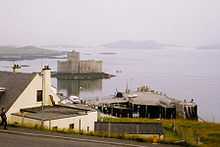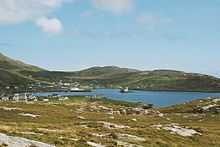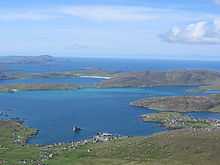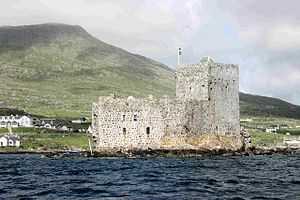Kisimul Castle
| Kisimul Castle | |
|---|---|
| Part of Barra, Western Isles | |
| Castlebay, Scotland | |
|
The walls and tower of the castle seen from the bay. | |
 Kisimul Castle | |
| Coordinates | 56°57′07″N 7°29′13″W / 56.952°N 7.487°W |
| Type | Rectangular castle |
| Height | 11 metres (36 ft) |
| Site information | |
| Owner | Clan MacNeil |
| Controlled by | Historic Scotland |
| Open to the public | Yes |
| Condition | Partially restored |
| Site history | |
| In use | Until 1838 |
| Materials | Granite |

Kisimul Castle (Scottish Gaelic: Caisteal Chiosmuil)[1] and also known as Kiessimul Castle,[2] is a small medieval castle located on a small island off Castlebay, Barra, in the Outer Hebrides, Scotland. It gets its name from the Gaelic cìosamul meaning "castle island".[3]
History
The earliest documentary record of Kisimul Castle dates from the mid 16th century.[4] Writing in 1549, Dean Munro stated of Barra that "Within the southwest end of this isle, ther enters a salt water loche, verey narrow in the entrey, and round and braide within. Into the middis of the saide loche there is ane ile, upon ane strenthey craige, callit Kiselnin, perteining to M’Kneil of Barray."[5] However, Campbell (1936) points out that Monro has in part confused the nearby Bàgh Beag with Bàgh a' Chaisteil.[6]
Kisimul sits on a rocky islet in the bay just off the coast of Barra. As it is completely surrounded by the sea, it can only be reached by boat and is all but impregnable. Kisimul has its own fresh water wells. Legend has it that this has been the stronghold of the MacNeils since the 11th century.
Kisimul was abandoned in 1838 when the island was sold, and the castle's condition deteriorated. Some of its stone was used as ballast for fishing vessels, and some even ended up as paving in Glasgow. The remains of the castle, along with most of the island of Barra, were purchased in 1937 by Robert Lister MacNeil, the then chief of Clan MacNeil, who made efforts at restoration.
In 2001 the castle was leased by the chief of Clan MacNeil to Historic Scotland for 1000 years for the annual sum of £1 and a bottle of whisky.[7] For the 2011 census the island was classified by the National Records of Scotland as an inhabited island that "had no usual residents at the time of either the 2001 or 2011 censuses."[1][Note 1]
Archaeological survey

Archaeological investigations were carried out at Kisimul Castle by Headland Archaeology, on behalf of Historic Scotland.[8] This involved some excavation, building recording and archival research. It was hoped that the project would help clarify the date of the castle and its sequence of construction. Another aim was to establish whether or not the island had been occupied before construction of the castle.

Excavation concentrated on areas of the courtyard, the basement of the tower and the bottom of a pit prison. At the east end of the courtyard there was a great deal of building rubble directly below the surface, some of which had mortar attached. This suggested that an earlier building had been demolished or collapsed, and the stone used to form a level courtyard. This happened before the building known as the kitchen was built. At the other end of the site a stone drain leading under the great hall was uncovered together with a paved stone surface. Above these was a layer containing large amounts of animal bone, shell and pottery. There were also floor surfaces within buildings that had been demolished.
During the excavation many finds were recovered. These included large quantities of animal bone and shell. Further study of these will allow us to discover more about the diet of those who lived in the castle. A large quantity of broken pottery was also found and appears to range in date from prehistoric times through the medieval period to the more recent past. A number of pieces of flint were recovered including a particularly fine flint blade. These tools together with some of the pottery show that people were using the island thousands of years before the present castle was built.
The most exciting find was recovered from one of the trenches dug within the tower. It is a fine, small gold object, shown here and in almost perfect condition. This is being looked at by specialists to discover its age and function.
Images
-

Kisimul Castle from Barra (1997)
-

-

-

View of Castlebay from Heaval
-

Kisimul Castle - Panorama vom Wehrgang
See also
Notes
- ↑ There were 93 inhabited islands listed in the 2011 census and more than 20 others that are inhabited from time to time but are not so listed.[1]
References
- ↑ 1.0 1.1 1.2 National Records of Scotland (15 August 2013) (pdf) Statistical Bulletin: 2011 Census: First Results on Population and Household Estimates for Scotland - Release 1C (Part Two). "Appendix 2: Population and households on Scotland’s inhabited islands". Retrieved 17 August 2013.
- ↑ "Barra, Kiessimul Castle". CANMORE. Retrieved 23 August 2013.
- ↑ Mac an Tàilleir, Iain (2003) Ainmean-àite/Placenames. (pdf) Pàrlamaid na h-Alba. Retrieved 26 August 2012.
- ↑ McDonald, R. Andrew (1997). The Kingdom of the Isles: Scotland's Western Seaboard c.1100-c.1336. East Linton, East Lothian, Scotland: Tuckwell Press. pp. 236–237. ISBN 1-898410-85-2.
- ↑ Monro, Sir Donald (1549) Description of the Western Isles of Scotland. William Auld. Edinburgh - 1774 edition.
- ↑ Campbell, John Lorne ed) (1936) The Book of Barra. Acair - reprinted 2006.
- ↑ "Islands gifted to residents". BBC News. 2003-09-05. Retrieved 2010-05-07.
- ↑ "Site Record for Barra, Kiessimul Castle Kisimul Castle; Caisteal Chiosmuil; Castlebay; Kiessamul Castle; Castle Bay; Bagh A' ChaisteilDetails Details". Rcahms.gov.uk. Retrieved 2012-10-23.
| ||||||||||||||||||||
| ||||||||||||||||||||||||||

